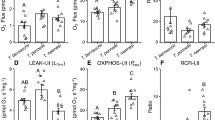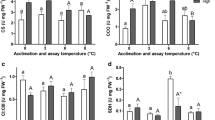Abstract
Diapausing embryos of the annual killifish Austrofundulus limnaeus have the highest reported anoxia tolerance of any vertebrate and previous studies indicate modified mitochondrial physiology likely supports anoxic metabolism. Functional mitochondria isolated from diapausing and developing embryos of the annual killifish exhibited VO2, respiratory control ratios (RCR), and P:O ratios consistent with those obtained from other ectothermic vertebrate species. Reduced oxygen consumption associated with dormancy in whole animal respiration rates are correlated with maximal respiration rates of mitochondria isolated from diapausing versus developing embryos. P:O ratios for developing embryos were similar to those obtained from adult liver, but were diminished in mitochondria from diapausing embryos suggesting decreased oxidative efficiency. Proton leak in adult liver corresponded with that of developing embryos but was elevated in mitochondria isolated from diapausing embryos. In metabolically suppressed diapause II embryos, over 95% of the mitochondrial oxygen consumption is accounted for by proton leak across the inner mitochondrial membrane. Decreased activity of mitochondrial respiratory chain complexes correlates with diminished oxidative capacity of isolated mitochondria, especially during diapause. Respiratory complexes exhibited suppressed activity in mitochondria with the ATP synthase exhibiting the greatest inhibition during diapause II. Mitochondria isolated from diapause II embryos are not poised to produce ATP, but rather to shuttle carbon and electrons through the Kreb’s cycle while minimizing the generation of a proton motive force. This particular mitochondrial physiology is likely a mechanism to avoid production of reactive oxygen species during large-scale changes in flux through oxidative phosphorylation pathways associated with metabolic transitions into and out of dormancy and anoxia.







Similar content being viewed by others
References
Addabbo F, Montagnani M, Goligorsky MS (2009) Mitochondria and reactive oxygen species. Hypertension 53:885–892
Barger JL, Brand MD, Barnes BM, Boyer BB (2003) Tissue-specific depression of mitochondrial proton leak and substrate oxidation in hibernating arctic ground squirrels. Am J Physiol Integr Comp Physiol 284:R1306–R1313
Bishop T, Brand MD (2000) Processes contributing to metabolic depression in hepatopancreas cells from the snail Helix aspersa. J Exp Biol 203:3603–3612
Bishop T, St-Pierre J, Brand MD (2002) Primary causes of decreased mitochondrial oxygen consumption during metabolic depression in snail cells. Am J Physiol 282:R372–R382
Boutilier RG, St-Pierre J (2002) Adaptive plasticity of skeletal muscle energetics in hibernating frogs: mitochondrial proton leak during metabolic depression. J Exp Biol 205:2287–2296
Brand MD (2005) The efficiency and plasticity of mitochondrial energy transduction. Biochem Soc Trans 33(pt 5):897–904
Brand MD, Chien LF, Diolez P (1994) Experimental discrimination between proton leak and redox slip during mitochondrial electron transport. Biochem J 297:27–29
Brand MD, Pakay JL, Ocloo J, Kokoszka DC, Brooks PS, Cornwall EJ (2005) The basal proton conductance of mitochondria depends on adenine nucleotide translocase content. Biochem J 392:353–362
Brooks PS (2005) Mitochondrial H+ leak and ROS generation: an odd couple. Free Radic Biol 38:12–23
Brown JCL, Gerson AR, Staples JF (2007) Mitochondrial metabolism during daily torpor in the dwarf Siberian hamster: role of active regulated changes and passive thermal effects. Am J Physiol 293(5):R1833–R1845
Cadenzas S, Buckingham J, St-Pierre J, Dickenson K, Jones R, Brand M (2000) AMP decreases the efficiency of skeletal-muscle mitochondria. Biochem J 351:307–311
Cannon B, Nedergaard J (2004) Brown adipose tissue: function and physiological significance. Physiol Rev 64:277–359
Chance B, Williams GR (1955) A simple and rapid assay of oxidative phosphorylation. Nature 175:1120–1121
Duerr JM, Hillman SS (1993) An analysis of pH tolerance and substrate preference of isolated skeletal muscle mitochondria from Bufo marinus and Rana catesbeiana. Comp Biochem Physiol 106(4):889–893
Duong CA, Sepulveda CA, Graham JB, Dickson KA (2006) Mitochondrial proton leak rates in the slow, oxidative myotomal muscle and liver of the endothermic shortfin mako shark (Isurus oxyrinchus) and the ectothermic blue shark (Prionace glauca) and leopard shark (Triakis semifasciata). J Exp Biol 209:2678–2685
Fangue NA, Richards JG, Schulte PM (2009) Do mitochondrial properties explain intraspecific variation in thermal tolerance? J Exp Biol 212:514–522
Groen AK, Wanders RJ, Westerhoff HV, van der Meer R, Tager JM (1982) Quantification of the contribution of various steps to the control of mitochondrial respiration. J Biol Chem 257(66):2754–2757
Hafner RP, Brown GC, Brand MD (1990) Analysis of the control of respiration rate, phosphorylation rate, proton leak rate and proton motive force in isolated mitochondria using the ‘top-down’ approach of metabolic control theory. Eur J Biochem 188(2):313–319
Heise K, Puntarulo S, Portner H, Abele D (2003) Production of reactive oxygen species by isolated mitochondria of the Antarctic bivalve Laternula elliptica (King and Broderip) under heat stress. Comp Biochem Biophys C 134(1):79–90
Hochachka PW, Somero GN (2002) Biochemical adaptation, mechanism and process in physiological evolution. Oxford University Press, New York
Hodges TK, Leonard RT (1974) Purification of a plasma membrane-bound adenosine triphosphatase from plant roots. Methods Enzymol 32(part B):392–406
Janssen AJM, Trijbels FM, Sengers RCA, Smeitink JAM, Van Den Heuvel LP, Wintjes TM, Stoltenborg-Hogenkamp BJM, Rodenburg JT (2007) Spectrophotometric assay for complex I of the respiratory chain in tissue samples and cultured fibroblasts. Clin Chem 53:729–734
Jastroch M, Buckingham J, Helwig M, Klingenspor M, Brand M (2007) Functional characterization of UCP1 in the common carp: uncoupling activity in liver mitochondria and cold-induced expression in the brain. J Comp Physiol B 177(7):743–752
Kadenbach B (2003) Intrinsic and extrinsic uncoupling of oxidative phosphorylation. Biochim Biophys Acta 1604:77–94
Kadenbach B, Ramzan R, Wen L, Vogt S (2009) New extension of the Mitchell theory for oxidative phosphorylation in mitochondria of living organisms. Biochim Biophys Acta. doi:10.1016/j.bbagen.2009.04.019
Kayes SM, Cramp RL, Hudson NJ, Franklin CE (2009) Surviving the drought: burrowing energy by increasing mitochondrial coupling. J Exp Biol 232:2248–2253
Korshunov SS, Skulachev VP, Starkov AA (1997) High protonic potential actuates a mechanism of production of reactive oxygen species in mitochondria. FEBS Lett 416(1):15–18
Kuznetsov AV, Schneeberger S, Seiler R, Brandacher G, Mark W, Steurer W, Saks V, Usson Y, Margreiter R, Gnaiger E (2004) Mitochondrial defects and heterogeneous cytochrome c release after cardiac cold ischemia and reperfusion. Am J Physiol Heart Circ Physiol 286:H1633–H1641
Lea MS, Hillman SS (1990) Effects of osmolality and solutes on performance of shark heart mitochondria. J Exp Zool 255:9–15
McMullen DC, Storey KB (2008) Mitochondria of cold hardy insects: Responses to cold and hypoxia assessed at enzymatic, mRNA and DNA levels. Insect Biochem Mol Biol 38:367–373
Mishra R, Shukla S (1994) Effects of endosulfan on bioenergetic properties of liver-mitochondria from the fresh-water catfish Clarias batrachus. Pestic Biochem Physiol 50(3):240–246
Murphy MP, Brand MD (1987) The control of electron flux through cytochrome oxidase. Biochem J 243(2):499–505
Pagliarini DJ, Dixon JE (2006) Mitochondrial modulation: reversible phosphorylation takes center stage? T Biochem Sci 31(1):26–34
Papa S, Guerrieri F, Capitanio N (1997) A possible role of slips in cytochrome c oxidase in the antioxygen defense system of the cell. Biosci Rep 17(1):23–31
Papa S, De Rasmo D, Scacco S, Signorile A, Technikova-Dobrova Z, Palmisano G, Sardanelli AM, Papa F, Panelli D, Scaringi R, Santeramo A (2008) Mammalian complex I: a regulable and vulnerable pacemaker in mitochondrial respiratory function. Biochim Biophys Acta 1777:719–728
Podrabsky JE (1999) Husbandry of the annual killifish Austrofundulus limnaeus with special emphasis on the collection and rearing of embryos. Environ Biol Fish 54:421–431
Podrabsky JE, Hand SC (1999) The bioenergetics of embryonic diapause in an annual killifish Austrofundulus limnaeus. J Exp Biol 202:2567–2580
Podrabsky JE, Hrbek T, Hand SC (1998) Physical and chemical characteristics of ephemeral pond habitats in the Maracaibo basin and Llanos region of Venezuela. Hydrobiologica 362:67–78
Podrabsky JE, Lopez JP, Fan TWM, Higashi R, Somero GN (2007) Extreme anoxia tolerance in embryos of the annual killifish Austrofundulus limnaeus: insights from a metabolomics analysis. J Exp Biol 210:2253–2266
Reynolds JA, Hand SC (2004) Differences in isolated mitochondria are insufficient to account for respiratory depression during diapause in Artemia franciscana embryos. Physiol Biochem Zool 77(3):366–377
Rolfe D, Brand MD (1996) Contribution of mitochondrial proton leak to skeletal muscle respiration and to standard metabolic rate. Am J Physiol 271:C1380–C1389
Rosing J, Harris DA, Kemp A, Slater EC (1975) Nucleotide-binding properties of native and cold-treated mitochondrial ATPase. Biochim Biophys Acta 376:13–26
Savina MV, Gamper NL (1998) Respiration and adenine nucleotides of Baltic lamprey (Lampetra fluviatilis L.) hepatocytes during spawning migration. Comp Biochem Physiol B 120:375–383
Savina MV, Emelyanova LV, Belyaeva EA (2006) Bioenergetic parameters of lamprey and frog liver mitochondria during metabolic depression and activity. Comp Biochem Physiol B 145:296–305
Scott ID, Nicholls DG (1980) Energy transduction in intact synaptosomes. Biochem J 186:21–33
Storey KB, Hochachka PW (1974) Enzymes of energy metabolism from a vertebrate facultative anaerobe, Pseudemys scripta. Turtle heart phosphofructokinase. J Biol Chem 249(5):1417–1422
St-Pierre J, Brand MD, Boutilier RG (2000a) The effect of metabolic depression on proton leak rate in mitochondria from hibernating frogs. J Exp Biol 209:1469–1476
St-Pierre J, Brand MD, Boutilier RG (2000b) Mitochondria as ATP consumers: cellular treason in anoxia. Proc Natl Acad Sci 97:8670–8674
Stuart JA, Gillis TE, Ballantyne JS (1998) Compositional correlates of metabolic depression in the mitochondrial membranes of estivating snails. Am J Physiol 275:R1977–R1982
Trzcionka M, Withers KW, Klingenspor M, Jastroch M (2008) The effects of fasting and cold exposure on metabolic rate and mitochondrial proton leak in liver and skeletal muscle of an amphibian, the cane toad Bufo marinus. J Exp Biol 211:1911–1918
Villani G, Attardi G (1997) In vivo control of respiration by cytochrome c oxidase in wild-type and mitochondrial DNA mutation-carrying human cells. Proc Natl Acad Sci 94(4):1166–1171
Wourms JP (1972a) Developmental biology of annual fishes. I. Stages in the normal development of Austrofundulus myersi Dahl. J Exp Zool 182:143–168
Wourms JP (1972b) The developmental biology of annual fishes III. Pre-embryonic and embryonic diapause of variable duration in the eggs of annual fishes. J Exp Zool 182:389–414
Acknowledgments
This work was supported by National Science Foundation grant IOB-0344578 to JEP and a Faculty Research Development Grant from George Fox University to JMD. The authors also wish to thank S.S. Hillman for helpful discussions and technical advice.
Author information
Authors and Affiliations
Corresponding author
Additional information
Communicated by H. V. Carey.
Rights and permissions
About this article
Cite this article
Duerr, J.M., Podrabsky, J.E. Mitochondrial physiology of diapausing and developing embryos of the annual killifish Austrofundulus limnaeus: implications for extreme anoxia tolerance. J Comp Physiol B 180, 991–1003 (2010). https://doi.org/10.1007/s00360-010-0478-6
Received:
Revised:
Accepted:
Published:
Issue Date:
DOI: https://doi.org/10.1007/s00360-010-0478-6




